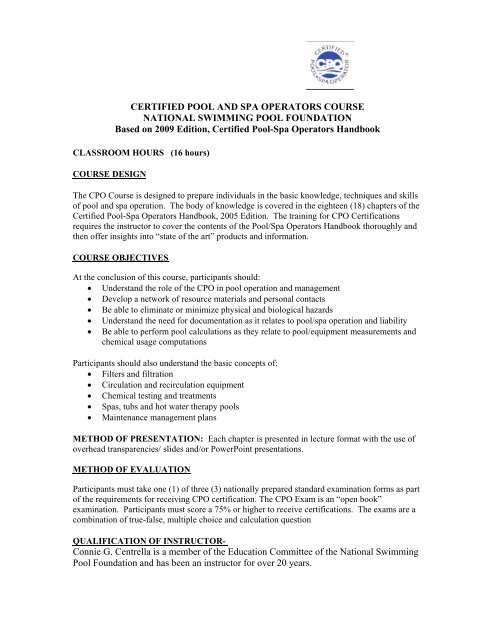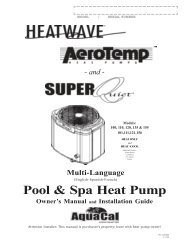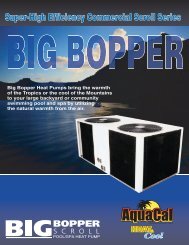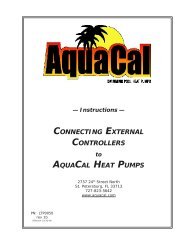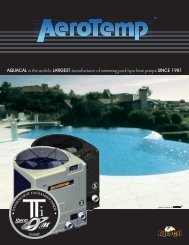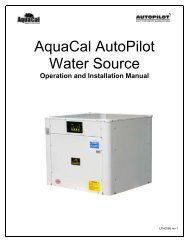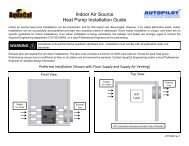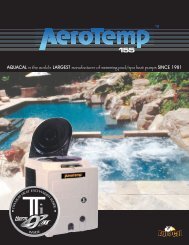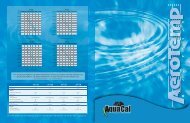Detailed CPO Course Outline - AquaCal
Detailed CPO Course Outline - AquaCal
Detailed CPO Course Outline - AquaCal
You also want an ePaper? Increase the reach of your titles
YUMPU automatically turns print PDFs into web optimized ePapers that Google loves.
CERTIFIED POOL AND SPA OPERATORS COURSENATIONAL SWIMMING POOL FOUNDATIONBased on 2009 Edition, Certified Pool-Spa Operators HandbookCLASSROOM HOURS (16 hours)COURSE DESIGNThe <strong>CPO</strong> <strong>Course</strong> is designed to prepare individuals in the basic knowledge, techniques and skillsof pool and spa operation. The body of knowledge is covered in the eighteen (18) chapters of theCertified Pool-Spa Operators Handbook, 2005 Edition. The training for <strong>CPO</strong> Certificationsrequires the instructor to cover the contents of the Pool/Spa Operators Handbook thoroughly andthen offer insights into “state of the art” products and information.COURSE OBJECTIVESAt the conclusion of this course, participants should:• Understand the role of the <strong>CPO</strong> in pool operation and management• Develop a network of resource materials and personal contacts• Be able to eliminate or minimize physical and biological hazards• Understand the need for documentation as it relates to pool/spa operation and liability• Be able to perform pool calculations as they relate to pool/equipment measurements andchemical usage computationsParticipants should also understand the basic concepts of:• Filters and filtration• Circulation and recirculation equipment• Chemical testing and treatments• Spas, tubs and hot water therapy pools• Maintenance management plansMETHOD OF PRESENTATION: Each chapter is presented in lecture format with the use ofoverhead transparencies/ slides and/or PowerPoint presentations.METHOD OF EVALUATIONParticipants must take one (1) of three (3) nationally prepared standard examination forms as partof the requirements for receiving <strong>CPO</strong> certification. The <strong>CPO</strong> Exam is an “open book”examination. Participants must score a 75% or higher to receive certifications. The exams are acombination of true-false, multiple choice and calculation questionQUALIFICATION OF INSTRUCTOR-Connie G. Centrella is a member of the Education Committee of the National SwimmingPool Foundation and has been an instructor for over 20 years.
Chapter 6 “Water Balance” 60 minutes 1.0 hrObjectives:• Discuss the basic concepts of water balance• Understand how to calculate and correct water balance using the saturation index• Become familiar with common chemicals used to balance water.Chapter 7 “Chemical Feed and Control” 60 minutes 1.0 hrObjectives:• Become familiar with the various methods that chemicals can be added to water• Understand chemical safetyChapter 8 “Pool & Spa Water Problems and Dosage” 60 minutes 1.0 hrObjectives:• Understand various water problems that can occur• Understand how to calculate the proper amount of chemicals to be added to adjustChapter 9-10 “Water Circulation and Filtration120 minutes 2.0 hrObjectives:• Discuss turnover rate and calculations• Discuss types of filter media and filtering aids• Perform calculations on filter sizing, GPM, and filter requirements• Discuss in depth operating procedures for high-rate sand, diatomaceous earthfilters, cartridge filters; backwashing, pre-coating and cleaning procedures• Discuss water distribution, outlets and inlets• Discuss recirculation equipment: pumps; pump sizing; piping and valves• Discuss Flow controllers; switches; flow meters; gauges• Discuss Gauges: influent and effluent and troubleshooting proceduresChapter 11 “Heating and Air Circulation” 30 minutes .5 hrObjectives:• Understand the types of energy loss• Become familiar with methods to prevent energy loss• Discuss design considerations for air circulation and improvementsChapter 12 “Pool Water Testing” 60 minutes 1.0 hrObjectives:• Discuss the importance of accurate water testing• Discuss proper testing techniques• Become knowledgeable of the proper testing techniques
Chapter 13 “Keeping Records” 30 minutes .5 hrObjective:• Understand the importance of record-keeping• Become familiar with the types of documentation necessary for aquatic facility• Discuss how proper documentation impacts the pool operator’s responsibilitiesChapter 14 “Facility Safety” 30 minutes .5 hrObjective:• Become familiar with ways to prevent access to facility• Become familiar with ways to be safe amount the water• Become familiar with ways to be safe in water• Storage and safe handling of pool chemicals• Emergency proceduresChapter 15 “Spa and Therapy Pool Operations” 60 minutes 1.0 hrObjectives:• Understand the importance of proper safety in spa operation• Discuss codes and standards for the operation of a spa• Identify various maintenance requirements for spas• Discuss entrapment and new standards for prevention• Understand how to calculate heaters based on water volume• Review safety procedures and signageChapter 16 “Maintenance Plans” 60 minutes 1.0 hrObjectives:• Discuss the importance of developing a maintenance plan• Recognize the Pool/Spa Operator Handbook as a resource for managementplanning• Review appendix for sample reports and proceduresChapter 17 “Troubleshooting” 30 minutes .5 hrObjectives:• To understand how to identify and correct problems with pumps and motors• To identify the causes of water loss• To identify and correct problems with pool heaters, filters and other equipmentChapter 18 “Facility Renovation and Design 30 minutes .5 hrObjectives:• Discuss factors to consider in modernizing or renovating a facility• Discuss development of a plan for renovations


